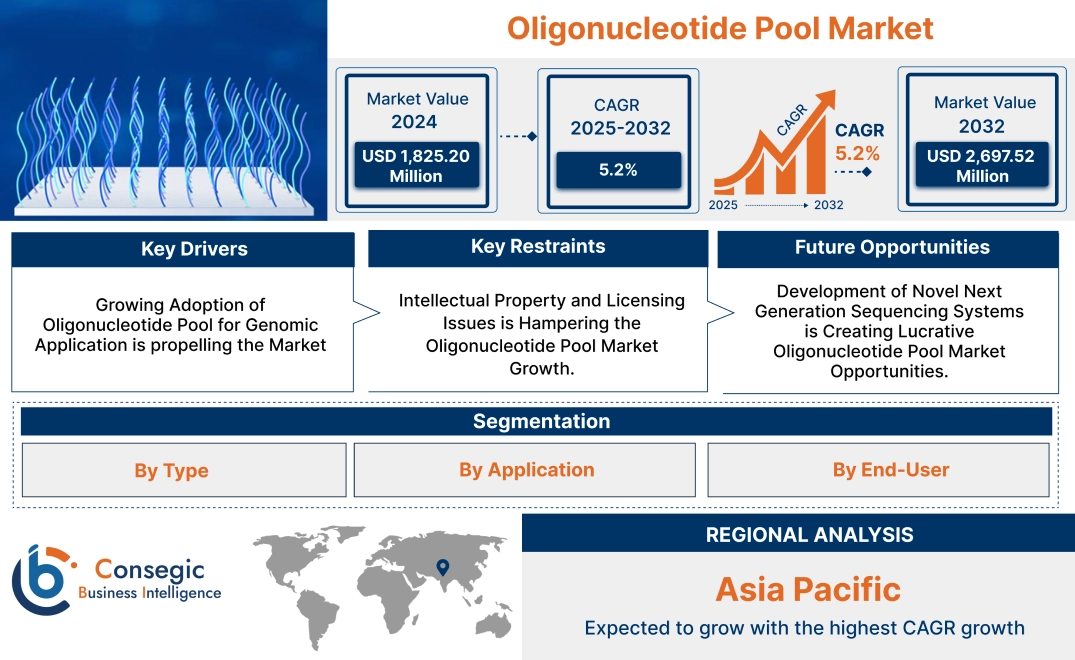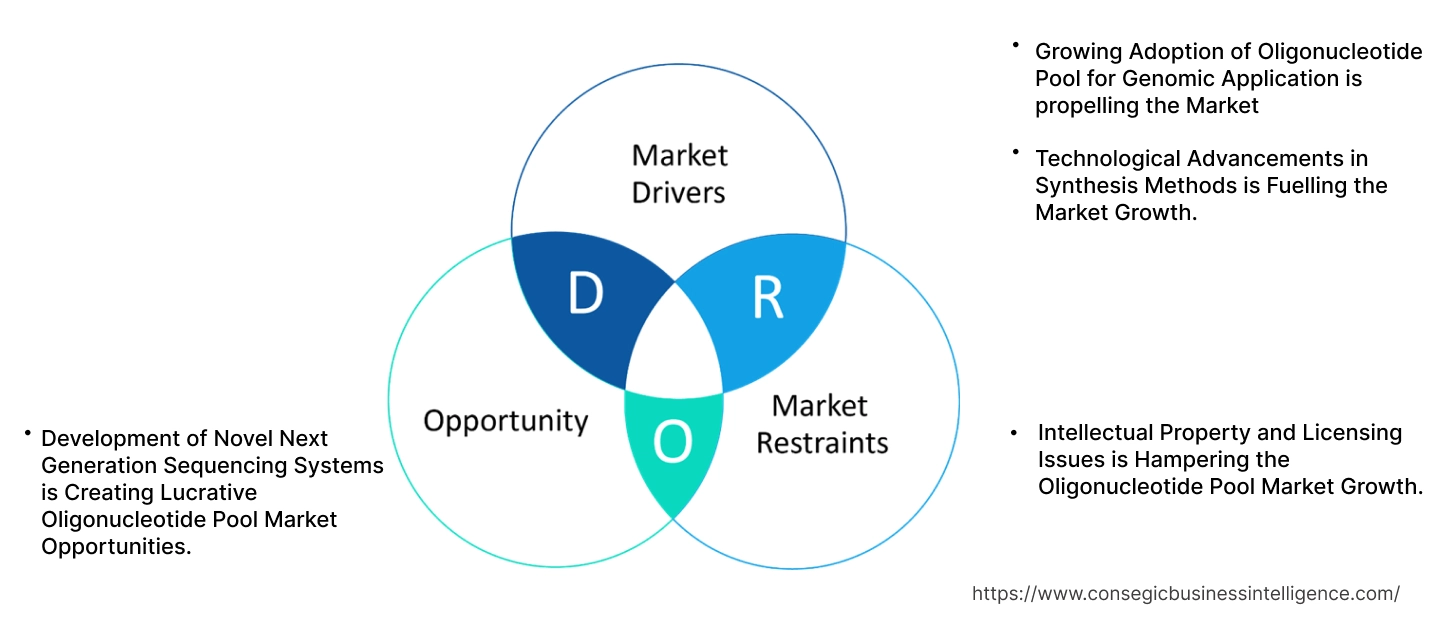Oligonucleotide Pool Market Size:
Oligonucleotide Pool Market size is growing with a CAGR of 5.2% during the forecast period (2025-2032), and the market is projected to be valued at USD 2,697.52 Million by 2032 from USD 1,825.20 Million in 2024.
Oligonucleotide Pool Market Scope & Overview:
An oligonucleotide pool is a complex mixture of synthetic DNA or RNA molecules, each with a defined sequence. These pools are composed of thousands or even millions of individual oligonucleotides, allowing for the simultaneous study of a large number of genetic variations or sequences. These pools are synthesized using advanced technologies that enable the parallel synthesis of multiple sequences, making them valuable tools for various applications in research, diagnostics, and therapeutics. They are essential in various applications such as gene synthesis, polymerase chain reaction (PCR), next-generation sequencing (NGS), and genetic testing. These methods enable researchers and clinicians to analyze and manipulate genetic material for a multitude of purposes.
The end-users of these advanced techniques primarily include diagnostic laboratories, which utilize them for disease detection and genetic profiling, pharmaceutical companies, which rely on these methods for drug development and testing, biotechnology firms, which harness molecular biology tools for innovations in health and agriculture, and research institutes, where fundamental and applied studies advance our understanding of biological processes and diseases.
Oligonucleotide Pool Market Dynamics - (DRO) :
Key Drivers:
Growing Adoption of Oligonucleotide Pool for Genomic Application is propelling the Market
The growing adoption of oligonucleotide pools for genomic applications is propelling oligonucleotide pool market growth. In recent years, there has been a significant increase in the utilization of these pools in various genomic applications, including gene synthesis, DNA sequencing, gene editing, and genome-wide association studies. It enables the design of highly specific and sensitive FISH probes, offering superior resolution and multiplexing capabilities compared to traditional methods. This allows for the simultaneous visualization of multiple genomic loci within a single cell, providing valuable insights into chromosomal organization, gene expression, and disease-related genetic abnormalities. Furthermore, the increasing adoption of gene editing technologies like CRISPR-Cas9, which mainly utilize oligonucleotide pools for guide RNA synthesis and donor template design. Manufacturers are introducing new pools of oligonucleotide for applications such as CRISPR guide RNAs or FISH probes.
- In October 2021, LC Sciences introduced OligoMix which is a pooled mixture of oligonucleotide sequences, specifically designed for high-throughput applications in genomics. This unique feature makes it a valuable tool for various applications including CRISPR Guide RNA Libraries, and FISH Probe Pools.
Thus, the rise in the adoption of pool of oligonucleotide for genomic applications is driving the market.
Technological Advancements in Synthesis Methods is Fuelling the Market Growth.
Technological advancements in oligonucleotide pool synthesis are fueling market growth. Traditional chemical synthesis methods have been significantly improved, enabling the production of longer and more complex pools with higher fidelity and purity. The emergence of microfluidic and parallel synthesis technologies has enhances oligonucleotide production, allowing for the rapid and cost-effective synthesis of large and diverse libraries. Furthermore, advancements in enzymatic synthesis methods offer alternative approaches for producing specific types of oligonucleotides, such as those containing modified nucleotides. Innovations in oligonucleotide synthesis methods, such as automated high-throughput platforms, have improved cost efficiency, scalability, and precision, making these products more accessible.
- In April 2021, Biolytic Lab Performance, Inc introduced Dr. Oligo 192XLc High Throughput Oligo Synthesizer, the newest addition to the Dr. Oligo platform. This synthesizer offers versatile synthesis capabilities using either plates or columns, ensuring a high-quality custom oligonucleotide synthesis experience while minimizing reagent consumption. It also features customizable options for both coupling and oxidation processes. This enables the development of novel oligonucleotide mixes for various applications.
Overall, these technological breakthroughs are expanding the scope of these pool applications and driving innovation across various sectors, including pharmaceuticals, diagnostics, and research.
Key Restraints:
Intellectual Property and Licensing Issues is Hampering the Oligonucleotide Pool Market Growth.
The growth of the market is significantly hindered by various intellectual property and licensing issues. The development of novel oligonucleotide sequences and synthesis methods mainly involves significant research and investment, leading to the generation of valuable intellectual property. Patent disputes and licensing negotiations are complex and time-consuming, potentially hindering the timely development and commercialization of innovative oligonucleotide-based technologies.
Furthermore, the licensing of intellectual property related to oligonucleotide synthesis and modification technologies increases the cost of producing oligonucleotide pools, potentially impacting market accessibility and affordability. A substantial number of synthetic methods and applications related to oligonucleotides are secured by existing patents, which creates formidable barriers for new companies looking to enter the market. This patent landscape not only restricts innovation by limiting access to crucial technologies but also drives up operational costs for established players who must navigate complex licensing agreements. Consequently, these intellectual property constraints stifle competition, ultimately impacting the overall progress and oligonucleotide pool market expansion.
Future Opportunities :
Development of Novel Next Generation Sequencing Systems is Creating Lucrative Oligonucleotide Pool Market Opportunities.
The continuous development of novel Next-Generation Sequencing (NGS) systems is creating lucrative market opportunities. These advanced sequencing technologies require highly specialized reagents, including complex oligonucleotide pools for library preparation, target enrichment, and sequencing chemistry. For example, the emergence of long-read sequencing technologies necessitates the development of longer and more complex pool for accurate read mapping and analysis. Manufacturers are introducing novel next generation sequencing systems which influences the use of novel oligonucleotides for various applications.
- In October 2024, Illumina introduced its MiSeq i100 Series of sequencing systems, designed to significantly accelerate NGS workflows for laboratories. These benchtop sequencers offer a dramatic reduction in turnaround time, enabling same-day results with sequencing runs as fast as four hours. The ability to achieve same-day results will accelerate research workflows that rely on NGS, such as those involving multiplex PCR, targeted sequencing, and gene editing. This speed will allow researchers to quickly iterate on experiments, optimize oligonucleotide pool designs, and obtain faster insights, ultimately accelerating the pace of discovery and innovation.
Thus, these advancements in NGS technology are creating a strong requirement for innovative pool designs and synthesis strategies, fostering significant oligonucleotide pool market opportunities.
Oligonucleotide Pool Market Segmental Analysis :
By Type:
Based on type, the market is categorized into DNA and RNA.
Trends in the Type:
- The trends for the use of RNA pool for gene expression studies are enabling the identification of differentially expressed genes.
- RNA oligonucleotide pools including siRNA are gaining popularity in gene silencing applications.
The DNA segment accounted for the largest oligonucleotide pool market share in 2024.
- DNA oligonucleotide pools consist of a diverse array of short, single-stranded DNA molecules, each characterized by a specific nucleotide sequence.
- These oligonucleotides are produced through advanced synthetic techniques that facilitate the simultaneous generation of multiple sequences in a single process.
- In gene synthesis, they are used to assemble and construct genes from smaller DNA fragments.
- In DNA sequencing, oligonucleotide pool serve as primers or probes, enhancing the accuracy and speed of sequencing methods.
- Furthermore, in the field of gene editing, they play a crucial role in techniques such as CRISPR-Cas9, where they help target specific gene locations for modification.
- Manufacturers are introducing these pools for various applications including CRISPR libraries, data storage, FISH analysis, and others.
- For instance, Integrated DNA Technologies (IDT) introduced oPools™ Oligo Pools that are collections of high-quality DNA oligonucleotides designed for various applications in molecular biology and genetics. They are particularly useful for CRISPR library construction, primer pools for multiplex PCR, gene construction, data storage, and FISH analysis.
- Overall, based on the oligonucleotide pool market analysis, the versatility and efficiency of DNA oligonucleotide pools make them essential components in modern molecular biology and genetic research, thus driving the
The RNA segment is expected to grow at the fastest CAGR over the forecast period.
- RNA oligonucleotide pools consist of a diverse collection of short, single-stranded RNA molecules, with each molecule featuring a precise and specific nucleotide sequence.
- These pools play a crucial role in various biological and experimental applications, providing researchers with a valuable resource for studying gene expression, RNA interactions, and other molecular processes.
- Each oligonucleotide in the pool is carefully designed to have a defined sequence, allowing for targeted experiments and investigations in the field of molecular biology.
- These pools are typically synthesized chemically and contain a vast number of different RNA sequences.
- They are widely used in research applications, particularly in the study of gene expression and RNA interference (RNAi).
- RNA pools are used to investigate gene function, identify RNA-protein interactions, and develop novel therapeutic approaches based on RNA interference.
- Thus, the aforementioned factors are influencing the oligonucleotide pool market expansion in the coming years.
By Application:
Based on application, the market is categorized into gene synthesis, polymerase chain reaction (PCR), next-generation sequencing (NGS), and genetic testing among others.
Trends in Application:
- The development of pools for multiplex PCR and FISH techniques is a growing trend
- Rising popularity of Next-Generation Sequencing influences the use of pools of oligonucleotide for numerous applications.
The polymerase chain reaction (PCR) segment accounted for the largest oligonucleotide pool market share in the year 2024.
- Oligonucleotide pools find significant utility in Polymerase Chain Reaction (PCR) applications.
- By employing pools of primers with varying sequences, researchers simultaneously amplify multiple target DNA regions in a single reaction.
- This multiplex PCR approach significantly enhances efficiency and throughput, enabling the analysis of complex biological samples and the identification of multiple genetic variations or pathogens within a single experiment.
- This versatility makes these pools indispensable tools for a wide range of PCR-based applications, including gene expression analysis, pathogen detection, and genetic screening.
- Manufacturers are introducing novel PCR systems such as multiplex PCR that use oligonucleotide pools for various molecular diagnostic applications.
- For instance, in April 2022, Bruker's introduces unique LiquidArray® Multiplex PCR Assays that significantly enhances the capabilities of oligonucleotide pools in several ways. This system uses these pools for microbial diagnostics, enabling rapid and accurate identification of pathogens in various clinical and environmental samples.
- Thus, the use of oligonucleotide pool in PCR is driving the oligonucleotide pool market demand.
The next generation sequencing (NGS) segment is expected to grow at the fastest CAGR over the forecast period.
- Oligonucleotide pools play a crucial role in Next-Generation Sequencing (NGS) technologies.
- In library preparation for NGS, oligonucleotide pools are utilized to introduce adapter sequences onto DNA fragments.
- These adapters contain unique sequences that allow for the attachment of the DNA fragments to the sequencing flow cell and facilitate subsequent sequencing reactions.
- Furthermore, these pools are employed in target enrichment strategies, such as capture probes and amplicon sequencing.
- Capture probes, designed from these pools, are used to selectively enrich specific genomic regions of interest, while amplicon sequencing utilizes primer pools to amplify targeted DNA regions prior to sequencing.
- Overall, these applications of these pools significantly enhance the efficiency and specificity of NGS experiments, enabling researchers to focus on specific genomic regions and obtain more informative sequencing data.
By End-User:
Based on end user, the market is categorized into diagnostic laboratories, pharmaceutical & biotechnology companies, research institutes, and others.
Trends in the End User:
- The rise in the trend for customization for various applications is influencing the use of polls of oligonucleotide.
- The rise in the number of research institutes is influencing the use of these pools.
The pharmaceutical & biotechnology companies segment accounted for the largest market share of 43.75% in the year 2024.
- Pharmaceutical and biotechnology companies are major end-users of oligonucleotide pools.
- These companies leverage oligonucleotide pools in various aspects of drug discovery and development, including gene therapy, antisense oligonucleotide (ASO) therapy, RNA interference (RNAi) therapeutics, and gene editing technologies such as CRISPR-Cas9.
- Oligonucleotide pools are utilized in the design and synthesis of therapeutic oligonucleotides, the development of diagnostic assays for disease monitoring, and the optimization of gene delivery systems.
- Furthermore, these companies utilize these pools for research and development purposes, such as gene expression analysis, target identification and validation, and the development of novel therapeutic modalities.
- The growing requirement for personalized medicine and advancements in genetic technologies are driving the increased utilization of these pools within the pharmaceutical and biotechnology industry.
- The rise in the development of new biotechnology companies enhances the use of these pool for various research applications.
- For instance, according to the data published by IBEF, states that the surge in biotechnology startups in India, with approximately 1,128 new entrants in 2021 alone, has created a dynamic environment for innovation. This development further accelerates the development and application of oligonucleotide pools.
- Thus, pools of oligonucleotides have become indispensable tools for the pharmaceutical and biotechnology industry, playing a critical role in advancing drug discovery and development, thus driving the oligonucleotide pool market trends.
The diagnostic laboratories segment is expected to grow at the fastest CAGR over the forecast period.
- Diagnostic laboratories extensively utilize oligonucleotide pools for a variety of applications.
- These include the development of DNA microarrays for gene expression profiling and genotyping, the creation of probes for in situ hybridization techniques, and the design of primers for multiplex PCR assays used in infectious disease diagnostics and genetic testing.
- Oligonucleotide pools are also instrumental in developing novel diagnostic tools, such as CRISPR-based diagnostics and other emerging technologies that leverage the power of nucleic acid-based detection methods.
- The ability to simultaneously analyze multiple targets using oligonucleotide pools significantly enhances the efficiency and accuracy of diagnostic procedures, enabling laboratories to provide faster and more comprehensive results.
- Thus, these aforementioned factors are driving the development of the segment in the coming years
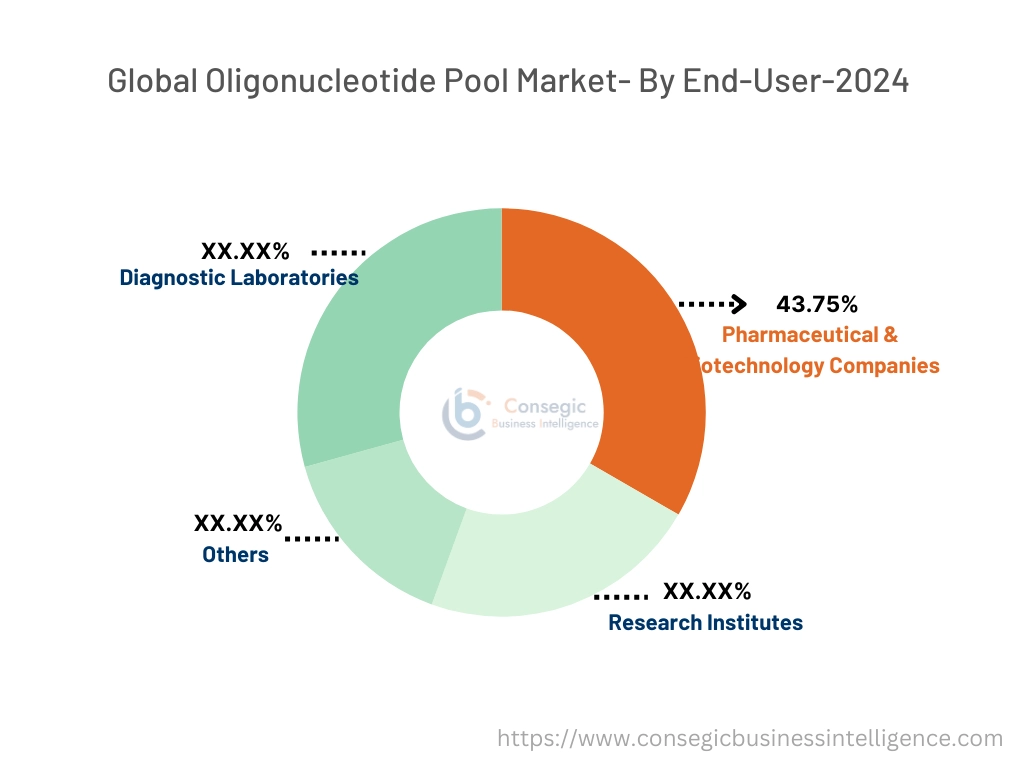
Regional Analysis:
The regional segment includes North America, Europe, Asia Pacific, the Middle East and Africa, and Latin America.
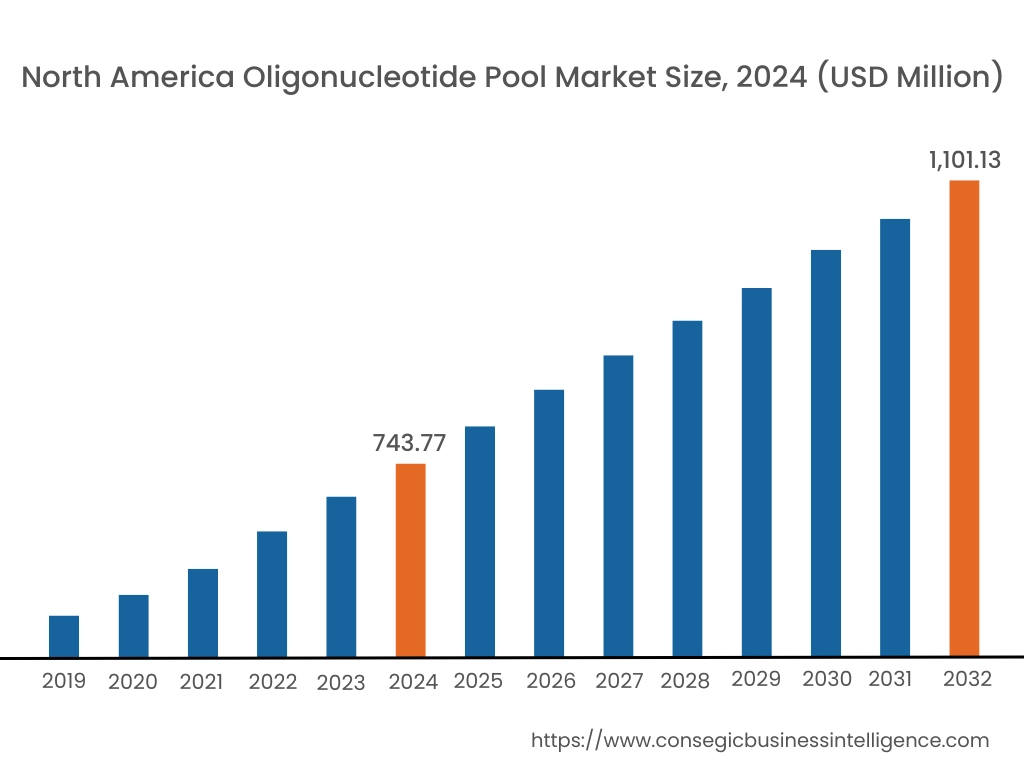
In 2024, North America accounted for the highest market share at 40.75% and was valued at USD 743.77 Million and is expected to reach USD 1,101.13 Million in 2032. In North America, U.S. accounted for the highest market share of 73.11% during the base year of 2024. North America is a significant market for oligonucleotide pools, driven by robust research and development activities in the life sciences industry. The region boasts a strong presence of pharmaceutical and biotechnology companies, academic institutions, and research centers actively engaged in research areas such as genomics, proteomics, and drug discovery. These entities utilize oligonucleotide pools extensively for various applications, including gene synthesis, DNA sequencing, gene editing, gene therapy, and the development of diagnostic assays. The presence of leading research institutions and a well-established healthcare infrastructure further contributes to the high requirement for oligonucleotide pools within North America. Additionally, the rise in the number of medical and diagnostic laboratories influences the use of oligonucleotide pool in various applications.
- According to the data published by LabFlorida, it states that there are over 200,000 clinical laboratories offering testing services in the United States. Hospital-based laboratories make up approximately 5% of all labs in the country and conduct many tests, accounting for 55% of the total testing volume. In contrast, independent laboratories, which represent around 3% of all laboratories, perform 32% of the testing volume. These laboratories influence the use of oligonucleotide pool for various testing applications.
Thus, based on the oligonucleotide pool market analysis, the rise in the healthcare infrastructure is influencing the use of these tools for various applications.
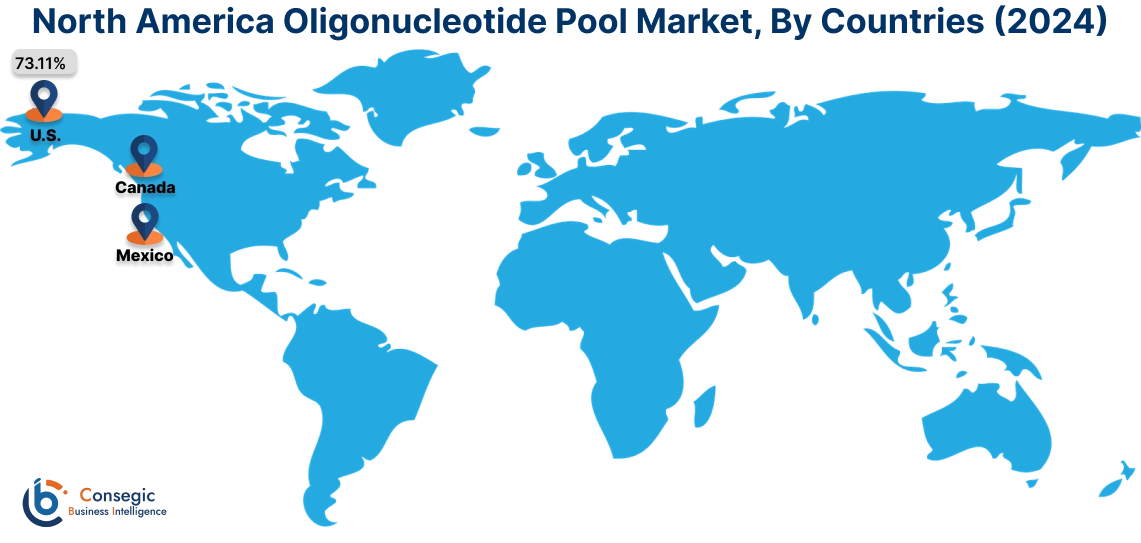
Asia Pacific is experiencing the fastest growth with a CAGR of 5.6% over the forecast period. The Asia Pacific region is witnessing a surge in the utilization of oligonucleotide pools, driven by rapid advancements in life sciences research and a growing emphasis on personalized medicine. Countries like China, India, Japan, and South Korea are at the forefront of this growth, with significant investments in research and development, a growing biotechnology industry, and a growing number of academic institutions actively engaged in genomics and molecular biology research. The requirement for oligonucleotide pools is further fueled by the increasing prevalence of infectious diseases, the rising incidence of chronic diseases, and the growing need for accurate and rapid diagnostic tools. Thus, the aforementioned factors are influencing the use of these tools in the Asia Pacific region.
Europe is a major hub for life sciences research and development, driving significant oligonucleotide pool market demand. The region boasts a strong presence of pharmaceutical and biotechnology companies, renowned research institutions, and a well-established healthcare infrastructure. Oligonucleotide pools are extensively utilized in European laboratories for various applications, including gene synthesis, DNA sequencing, gene editing, gene therapy, and the development of diagnostic assays. The emphasis on scientific innovation and advancements in healthcare within the European Union further fuels the demand for these versatile tools, contributing to the region's position as a global leader in life sciences research. European manufacturers and suppliers are at the forefront of technological advancements in research and development, further driving the marker trajectory across the region.
The Middle East and Africa are emerging markets for oligonucleotide pools, driven by growing investments in healthcare infrastructure and increasing research activities in life sciences. While the market is still developing, there is a growing demand for advanced diagnostic tools and therapeutic solutions in these regions. The utilization of oligonucleotide pools in infectious disease diagnostics, particularly for the detection and surveillance of emerging pathogens, is gaining significant traction. Furthermore, research activities in areas such as personalized medicine and gene therapy are expected to drive the demand for high-quality oligonucleotide pools in the coming years. Overall, the Middle East and Africa are emerging markets for oligonucleotide pools, driven by increasing investments in healthcare infrastructure and growing research activities in life sciences. The demand for advanced diagnostic tools and therapeutic solutions is on the rise, creating significant prospects for the application of these pools in infectious disease diagnostics, personalized medicine, and gene therapy research. Thus, these aforementioned factors are propelling the oligonucleotide pool market trends.
The Latin American market for oligonucleotide pools is experiencing growth, driven by increasing investments in research and development activities, particularly in the areas of infectious disease research and personalized medicine. The region is witnessing a rise in the prevalence of chronic diseases and infectious diseases, necessitating the development of advanced diagnostic tools. Oligonucleotide pools play a crucial role in enabling rapid and accurate diagnosis of infectious diseases through multiplex PCR assays and other molecular diagnostic techniques. Furthermore, the growing interest in personalized medicine and the development of novel therapeutics is driving the demand for oligonucleotide pools in research and development activities within the region.
Top Key Players and Market Share Insights:
The global Oligonucleotide Pool market is highly competitive with major players providing precise products to the national and international markets. Key players are adopting several strategies in research and development (R&D) and product innovation to hold a strong position in the global Oligonucleotide Pool market. Key players in the market include-
- Creative Biogene (United States)
- Agilent (United States)
- CustomArray (U.S.)
- Sigma Aldrich (U.S.)
- TriLink BioTechnologies (U.S.)
- Integrated DNA Technologies, Inc (United States)
- GenScript (United States)
- Twist Bioscience (Canada)
- LC Sciences (United States)
- Illumina (United States)
Oligonucleotide Pool Market Report Insights :
| Report Attributes | Report Details |
| Study Timeline | 2019-2032 |
| Market Size in 2032 | USD 2,697.52 Million |
| CAGR (2025-2032) | 5.2% |
| By Type |
|
| By Application |
|
| By End-User |
|
| By Region |
|
| Key Players |
|
| North America | U.S. Canada Mexico |
| Europe | U.K. Germany France Spain Italy Russia Benelux Rest of Europe |
| APAC | China South Korea Japan India Australia ASEAN Rest of Asia-Pacific |
| Middle East and Africa | GCC Turkey South Africa Rest of MEA |
| LATAM | Brazil Argentina Chile Rest of LATAM |
| Report Coverage |
|
Key Questions Answered in the Report
How big is the Oligonucleotide Pool market? +
In 2024, the Oligonucleotide Pool market is USD 1,825.20 Million.
Which is the fastest-growing region in the Oligonucleotide Pool market? +
Asia Pacific is the fastest-growing region in the Oligonucleotide Pool market.
What specific segmentation details are covered in the Oligonucleotide Pool market? +
Type, Application, and End User segmentation details are covered in the Oligonucleotide Pool market.
Who are the major players in the Oligonucleotide Pool market? +
Creative Biogene (United States), Agilent (United States), Integrated DNA Technologies, Inc (United States) are some of the major players in the market.
